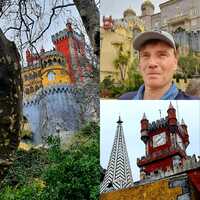Photo. The Palace of Sintra creates imaginations of mystery and discovery. © Travel Explorations.
Here I took my time to explore the amazing palace and surroundings. Both the palace and the dense forest around are full of labrinths which take you secret places all around. One of the place I found was on the top of the place, the Sintra Palace chapel.
This palace, also called Town Palace (Palácio da Vila), is located in the town of Sintra, in the Lisbon District of Portugal. The Pena Palace of Sintra is a Romanticist castle completed in 1854. It is situated on a top of a hill above the town of Sintra and can be easily spotted from Lisbon on a clear day. It is the best-preserved medieval royal residence in Portugal, being inhabited more or less continuously from at least the early 15th century to the late 19th century.
It is part of the cultural landscape of Sintra, a designated UNESCO World Heritage Site. The Pena Park is a vast forested area spread out over 200 hectares and it surrounds the palace. The park is filled with walking paths, secret paths, pavilions, lakes, ponds and exotic trees designed based on the orders given by King Ferdinand which is where the exotic taste comes from.
It was one of two castles at what is now Sintra in the Moorish Al-Andalus era that began with the Umayyad conquest of Hispania in the 8th century. The other, now known as the Castelo dos Mouros (Castle of the Moors), located atop a high hill overlooking modern Sintra, is now a romantic ruin.
The castle was the residence of the Islamic Moorish Taifa of Lisbon rulers of the region. The earliest mention in a source is by Arab geographer Al-Bacr. In the 12th century the village was conquered by King Afonso Henriques, who took the 'Sintra Palace' castle for his use. The blend of Gothic, Manueline, Moorish, and Mudéjar styles in the present palace is, however, mainly the result of building campaigns in the 15th and early 16th centuries (source: Wikipedia).
The site of Pena Palace used to be a medieval chapel dedicated to Our Lady of Pena until it was ordered by King Manuel I to build a monastery which was donated to the Order of Saint Jerome. However, by the 18th century, it was majorly damaged by the great Lisbon earthquake. Fortunately, the chapel managed to survive without being ruined at all, which surprised the Portugal King, Ferdinand II. It was then decided by the king to acquire the monastery and its surrounding to build what we see today as the grand Pena Palace.
The castle was built with a purpose to serve as a summer residence of the King. However, after his death, the palace was passed into the possession of his second wife Elisa Hensler, Countess of Edla, who later sold the palace to King Luis. In 1889 it was purchased by the Portuguese State and was later classified as a national monument and transformed into a museum.
Stein Morten Lund, february 2022
Additonal information
Information about the palace and tickets:
https://www.penapalacetickets.com/national-palace-of-pena-sintra/












